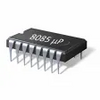Run different scientific microprocessor simulations without the need to purchase a bunch of expensive equipment
Run different scientific microprocessor simulations without the need to purchase a bunch of expensive equipment
Vote: (75 votes)
Program license: Free
Developer: jithin jose
Version: 1.0.0
Works under: Windows
Vote:
Program license
(75 votes)
Free
Developer
Version
jithin jose
1.0.0
Works under:
Windows
Pros
- Cost-effective alternative to physical hardware
- Simple and Advanced modes cater to different skill levels
- User-friendly interface enhances learning experience
- Program without risk of damaging actual microprocessor
- Renders organized instruction sets and simulates real-time effects
Cons
- May contain instruction errors that require troubleshooting
- Lacks integrated tutorial; separate download needed for guidance
- Some complex instructions might not work properly
Efficient Microprocessor Programming with 8085 Simulator
The 8085 Simulator by Jithin Jose and J-Tech Softwares represents an essential tool for both students and professionals engaging in microprocessor programming. This simulation software effectively eliminates the need for physical hardware, thus minimizing both cost and risk of damage in learning environments. It serves as a digital substitute for working with the actual Intel 8085 microprocessor, offering an array of features that facilitate learning and development in processor programming.
Understanding the Intel 8085 Microprocessor
The 8085 microprocessor, released by Intel in the mid-70s, is renowned for its reduction in support circuitry requirements, enabling the development of simpler and more affordable microcomputer systems. While it has since been superseded by more advanced models, the 8085 remains a staple in educational settings, often forming the foundation of microprocessor courses due to its straightforward architecture and instruction set. Traditionally, training kits would include the hardware and documentation necessary for hands-on learning; however, software simulators such as the 8085 Simulator provide a modern, risk-free alternative for mastering the intricacies of programming.
Designed for Educators and Learners Alike
J-Tech Softwares' 8085 Simulator is crafted for users ranging from novices to seasoned programmers. The interface is straightforward, promoting a user-friendly experience. The software is organized into two distinct modes: Simple and Advanced. Simple Mode is ideal for beginners, providing preset instructions alongside intuitive interrupt and restart controls. Advanced Mode, on the other hand, caters to experienced users by allowing custom instruction input and detailed control over execution speed. The versatility of these modes ensures that the software grows with the user’s proficiency level.
Simulation Features for Enhanced Learning
Advantageous to students and professionals alike, the software boasts a well-organized instruction list displayed in a clear table format. Users can assign labels, input mnemonic instructions with operands, and seamlessly observe the effects on corresponding memory addresses and register values. Although the software does not contain an integrated tutorial, it compels users to have a basic understanding of the microprocessor’s internal structure, addressing modes, and instruction set, thus targeting those with a preliminary grasp of the subject matter.
Areas of Improvement and Reliability
Despite its myriad of benefits, the 8085 Simulator could benefit from some refinements, particularly regarding the accuracy of instructions and compatibility with more complex commands. Additionally, to fully leverage the software, users might need to troubleshoot instruction errors occasionally. Nevertheless, the 8085 Simulator stands out as a reliable and efficient platform for microprocessor programming and practice, negating the necessity for additional resources and hardware.
Pros
- Cost-effective alternative to physical hardware
- Simple and Advanced modes cater to different skill levels
- User-friendly interface enhances learning experience
- Program without risk of damaging actual microprocessor
- Renders organized instruction sets and simulates real-time effects
Cons
- May contain instruction errors that require troubleshooting
- Lacks integrated tutorial; separate download needed for guidance
- Some complex instructions might not work properly




